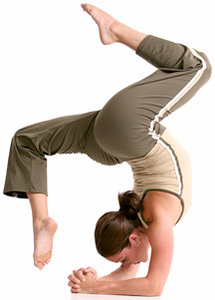You've Got to be Flexible
By Editorial Staff
Flexibility is the ability to move the joints and muscles through a normal range of motion, and it's an important fitness measure; in fact, it's one of the five health-related components of physical fitness, along with muscular strength, muscle endurance, cardiorespiratory endurance and body composition. We lose flexibility as we age, which means we need to develop it while we're young and then maintain it when we're older.
The Why
Here are just a few of the health benefits attributable to a regular flexibility and stretching program:
- Increased circulation: Stretching increases blood flow to muscles, nourishing them and eliminating waste products. It also helps shorten recovery time following a muscle injury.
- Improved posture: Stretching helps keep muscles loose, which allows you to maintain proper posture. Better posture means less discomfort caused by poor posture-related conditions such as back pain.
- Better coordination: Flexibility improves range of motion, which maximizes balance, coordination and mobility. This is especially important to minimize the risk of falls as we age.
- Stress relief: Because flexible muscles are loose muscles, they're less prone to tighten up during periods of excess stress and tension.
The How
 OK, now you know why flexibility is so important. Let's talk about how to make stretching/flexibility a part of your weekly routine. According to the Mayo Clinic, there are six essential guidelines to keep in mind when stretching:
OK, now you know why flexibility is so important. Let's talk about how to make stretching/flexibility a part of your weekly routine. According to the Mayo Clinic, there are six essential guidelines to keep in mind when stretching:
- Warm up first. You're more likely to pull a muscle when it's cold. Start off with five minutes of walking, light limb movement or a favorite low-intensity exercise.
- Hold each stretch for 30-60 seconds, remembering to breathe. Simply put, it takes time to stretch tissues safely. Go too fast and you could be in for trouble in the form of a muscle tear. For most muscle groups, a single 30-60-second stretch is adequate.
- Don't bounce. Speaking of muscle tears, bouncing during a stretch can cause microtears in the muscle, leaving scar tissue as the muscle heals, which will only make the muscle tighter and more prone to future pain and inflexibility.
- Avoid pain. You shouldn't feel pain during a stretch. If you do, you've gone too far and need to back off and hold the stretch in a pain-free position.
- Stretch both sides. Joint range of motion needs to be as equal as possible on both sides of the body; after all, if only half the body is flexible, the other half can still cause problems.
- Stretch before and after exercise. Stretch them lightly before a workout and then more thoroughly after your workout. Stretching before activity improves flexibility and reduces injury risk; stretching after exercise relaxes tired muscles and reduces muscle soreness and stiffness.

